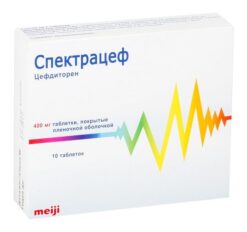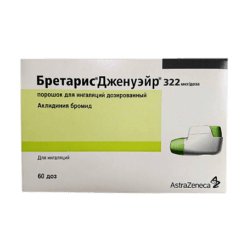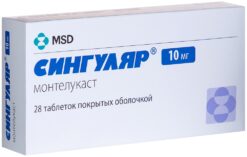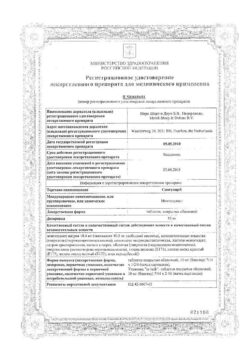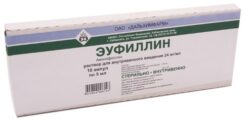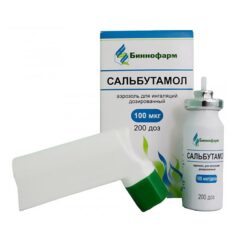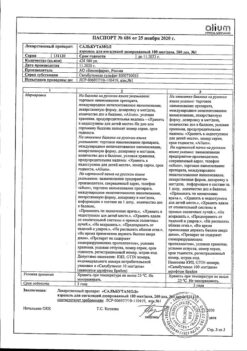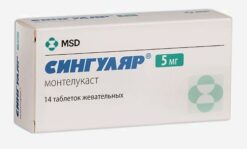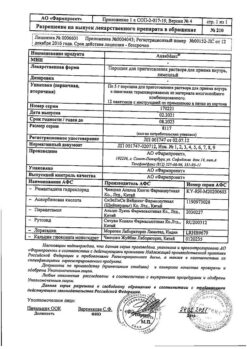No products in the cart.
Tiotropium nativ, 18 mcg 30 pcs
€1.00
Out of stock
(E-mail when Stock is available)
Description
Tiotropium-Native is a long-acting m-cholinoblocker. It has the same affinity for various subtypes of muscarinic receptors from M1 to M5. Inhibition of M3 receptors in the respiratory tract results in relaxation of smooth muscles. Bronchodilator (bronchodilator) effect lasts for at least 24 hours and depends on the dose of tiotropium bromide.
The significant duration of action is probably due to the very slow dissociation of tiotropium bromide from M3 receptors compared to ipratropium bromide. When administered by inhalation, tiotropium bromide as an N-quaternary anticholinergic agent has a local selective effect, while in therapeutic doses does not cause systemic m-cholinoblocking adverse reactions.
The dissociation of tiotropium bromide from M2 receptors is faster than from M3 receptors. High affinity for receptors and slow dissociation cause pronounced and prolonged bronchodilator effect in patients with chronic obstructive pulmonary disease (COPD). Bronchodilation after inhalation of tiotropium bromide results from local rather than systemic effects.
Tiotropium bromide significantly increases lung function (forced expiratory volume in 1 second – FEF1, forced vital capacity of lungs – VEF) 30 minutes after a single dose for 24 hours.
Pharmacodynamic equilibrium is achieved within the first week, and a pronounced bronchodilator effect is observed on the third day. Tiotropium bromide significantly increases morning and evening peak expiratory flow rate (PEF). The use of tiotropium bromide for one year does not cause a decrease in the effectiveness with respect to bronchodilation.
Tiotropium bromide significantly reduces dyspnea throughout the duration of treatment, significantly improves exercise tolerance, significantly reduces the number of COPD exacerbations and increases the time to first exacerbation, and significantly reduces the number of hospitalizations associated with COPD exacerbations and increases the time to first hospitalization. Tiotropium bromide leads to a sustained improvement in SPH1 after four years of use with no change in the rate of annual decline in SPH1.
There is evidence of a 16% reduction in the risk of death during treatment with tiotropium bromide and evidence of an increase in time to first exacerbation with a 17% reduced risk of developing exacerbations when using tiotropium bromide compared to taking salmeterol.
Tiotropium bromide also increases time to first severe (requiring hospitalization) exacerbations and reduces the annual number of moderate or severe (requiring hospitalization) exacerbations.
Pharmacokinetics
Intake
. When administered by inhalation, the absolute bioavailability of tiotropium bromide is about 19%, which indicates a high bioavailability of the active substance fraction reaching the lungs. Maximum concentration of tiotropium bromide in blood plasma (Cmax) after inhalation is reached after 5-7 minutes. Cmax of tiotropium bromide in plasma at equilibrium in patients with COPD is about 12 pg/ml and decreases rapidly, indicating the multicompartment type of distribution of tiotropium bromide. In the equilibrium state, the basal plasma concentration of tiotropium bromide is approximately 1.71 pg/ml.
Distribution
The binding of tiotropium bromide to plasma proteins is 72% of the administered dose of the drug; the volume of distribution is 32 l/kg.
Tiotropium bromide does not penetrate through the blood-brain barrier.
Metabolism
The degree of biotransformation is insignificant. Tiotropium bromide undergoes non-enzymatic cleavage via ether bonds to ethanol-N-methylscopic acid and dithienylglycolic acid, which do not bind to muscarinic receptors. Tiotropium bromide (< 20% of the dose after intravenous administration) is metabolized by cytochrome P450, this process depends on oxidation and subsequent conjugation with glutathione to form various metabolites.
Metabolism impairment may occur with CYP2D6 and CYP3A4 isoenzyme inhibitors (quinidine, ketoconazole and gestodine). Thus, CYP2D6 and SUR3A4 isoenzymes are included in the metabolism of tiotropium bromide. Tiotropium bromide does not inhibit the CYP1A1, 1A2, 2B6, 2C9, 2C19, 2D6, 2E1 or 3A isoenzymes in human liver microsomes even in supertherapeutic concentrations.
Elimination
The elimination half-life (T1/2) of tiotropium bromide after inhalation varies from 27 to 45 hours. Total clearance when administered intravenously to healthy volunteers is 880 ml/min. Tiotropium bromide after intravenous administration is mainly excreted unchanged by the kidneys – 74%. After inhalation renal excretion in equilibrium is 7% per day of the dose, the remaining unabsorbed part is excreted through the intestine.
The renal clearance of tiotropium bromide exceeds that of creatinine, indicating tubular secretion of tiotropium bromide. After long-term administration of tiotropium bromide once daily in patients with COPD, pharmacokinetic equilibrium is reached by day 7 and no cumulation is observed.
Tiotropium bromide has linear pharmacokinetics within therapeutic limits.
Pharmacokinetics in selected patient groups
Elderly and elderly patients
Elderly and older patients have decreased renal clearance of tiotropium bromide (365 mL/min in patients with COPD < 65 years to 271 mL/min in patients with COPD > 65 years). These changes do not result in a corresponding increase in the area under the pharmacokinetic concentration-time curve (AUC0-6h) or Cmax values.
Patients with impaired renal function
In patients with COPD and mild renal impairment (creatinine clearance (CK) 50-80 ml/min), inhaled tiotropium bromide once daily in equilibrium results in a 1.8-30% increase in AUC0-6h. The Cmax value is maintained the same as in patients with normal renal function (CK > 80 ml/min).
In patients with COPD and moderate to severe renal impairment (KC < 50 ml/min), intravenous administration of tiotropium bromide leads to a two-fold increase in its plasma concentration (AUC0-4h increased by 82% and Cmax value increased by 52%) compared to patients with COPD and normal renal function. A similar increase in plasma concentration of tiotropium bromide is also observed after inhalation.
Patients with impaired hepatic function
. Liver insufficiency is not thought to have a significant effect on the pharmacokinetics of tiotropium bromide because it is mostly excreted by the kidneys and by non-enzymatic ester bond cleavage to form metabolites that do not bind to muscarinic receptors.
Indications
Indications
Maintenance therapy in patients with COPD, including chronic bronchitis and pulmonary emphysema (maintenance therapy for persistent dyspnea and to prevent exacerbations).
Active ingredient
Active ingredient
Composition
Composition
Composition per 1 capsule:
Active ingredient:
– Tiotropium bromide monohydrate – 22.5 µg
(in terms of tiotropium) – (18 mcg)
– Excipients:
– Sodium benzoate – 20 µg
– Lactose monohydrate – 10 mg
– Capsules solid #3:
– Hypromellose – 100%
How to take, the dosage
How to take, the dosage
Tiotropium-Nativ is administered as an inhalation of one capsule daily at a time using an Inhaler CDM® inhaler.
The drug should not be swallowed.
Tiotropium-nativ should not be used more than once daily.
The elderly and elderly patients and patients with impaired renal or hepatic function may take Thiotropium-nativ in the recommended doses.
Patients with moderate to severe renal impairment receiving Thiotropium-nativ in combination with other drugs that are mainly excreted by the kidneys, however, should be closely monitored.
Interaction
Interaction
The use of Thiotropium-Nativ in combination with other drugs commonly used for the treatment of COPD: sympathomimetics, methylxanthines, oral and inhaled glucocorticosteroids is possible.
The co-administration with long-acting β2-adrenomimetics, inhaled glucocorticosteroids and their combinations does not affect the effect of tiotropium bromide.
The continuous co-administration of other anticholinergic drugs and Tiotropium-nativ has not been studied and, therefore, is not recommended.
Directions for use
Directions for use
Tiotropium-Nativ is administered as an inhalation of one capsule daily at a time using an Inhaler CDM® inhaler.
The drug should not be swallowed.
Tiotropium-nativ should not be used more than once a day.
Elderly and elderly patients and patients with impaired renal or hepatic function may take Thiotropium-nativ in the recommended doses. However, close monitoring of patients with moderate to severe renal impairment receiving Tiotropium-Nativ in combination with other drugs that are mainly excreted by the kidneys is necessary.
Inhaler CDM® Inhaler Instructions for Use.
The CDM® Inhaler is a plastic device with a movable top and a retractable capsule compartment, about 6 cm high. “The CDM® Inhaler is a single-dose inhaler that allows you to dose and inhale the drug in very small doses. The Tiotropium-Nativ enters the patient’s airway with the air currents when actively inhaling through the mouthpiece. The Tiotropium-Nativ capsules should only be used with the CDM® Inhaler to ensure proper dosing.
The CDM® Inhaler is very easy to use. When using it
You need to follow the step-by-step instructions below:
Remove the clear cap from the Inhaler CDM® device as shown in Figure 1.
Hold the device firmly with one hand and use your index finger and thumb to open the capsule compartment as shown in Figure 2. To do this, use your index finger to press “PUSH” on the sliding part of the Inhaler CDM®, sliding the compartment in the opposite direction.
Holding the device with one hand, insert the drug capsule into the compartment slot (Figure 3).
Make sure the capsule is properly inserted into the slot (Figure 4).
Holding the Inhaler CDM® upright, close the compartment by pressing backward with your thumb until you hear a click (Figure 5).
Hold the Inhaler CDM® ” device strictly vertically (Figure 6).
Put it in working order as shown in Fig. 7. To do this, firmly press the mouthpiece so that the arrow on the housing disappears beyond the borders of the bottom of the device to the top line. Then release the mouthpiece to return it to its original position. This will puncture the capsule, allowing the medication to enter the mouthpiece.
Please note: Due to the destruction of the gelatin capsule, small pieces of gelatin may enter your mouth or throat as a result of inhalation. To minimize this phenomenon, do not pierce the capsule more than once.
Caution: you should exhale before inhaling (Fig.
8). Do not exhale through the mouthpiece!
Gently grasp the Inhaler CDM® mouthpiece with your teeth, wrap your lips tightly around it and take a deep and strong breath through your mouth (Figure 9). You will hear a vibrating sound inside the capsule compartment as the capsule rotates and disperses the medicine. Caution: The mouthpiece must not be chewed or pressed hard with your teeth! Do not press on the mouthpiece when inhaling. This may block the movement of the capsule. Hold your breath for about 10 seconds or longer, as long as possible.
Remove the inhaler from your mouth. Take a slow exhalation. Then breathe normally.
Repeat steps 8-9 again, for a guaranteed inhaled dose of medication.
After inhalation, open the capsule compartment (step 2), remove the empty capsule
and then close it as shown in Fig. 5.
Please note:
When inhaling, try not to cover the holes on the sides of the mouthpiece. This prevents the air from moving freely around inside the mouthpiece, reducing dispersion of the capsule contents.
Always close the Inhaler CDM® cap tightly after use to keep the mouthpiece clean.
Clean the outside of the mouthpiece regularly (once a week) with a dry cloth.
There have been anecdotal reports of patients accidentally swallowing the entire capsule without using the inhaler. Most of these cases are not associated with adverse events. The healthcare professional should explain to the patient how to use the medication correctly, especially if the patient does not improve breathing after inhalation.
Special Instructions
Special Instructions
Tiotropium-nativ, as a once-daily bronchodilator for maintenance treatment, is not intended as initial therapy for acute attacks of bronchospasm, i.e., emergencies.
After inhalation of Tiotropium-nativ, immediate hypersensitivity reactions may develop. Like other inhaled drugs, Tiotropium-nativ may cause paradoxical bronchospasm.
Patients should be familiarized with the rules for using Tiotropium-nativ capsules with an inhaler. The powder should not be allowed to get into the eyes. Pain in the eye or discomfort, blurred vision, visual halos combined with red eyes, conjunctival congestion, and corneal edema may indicate an acute attack of closed angle glaucoma.
If any combination of these symptoms develops, seek immediate medical attention. The use of medications that cause miosis is not an effective treatment option in this case.
Tiotropium-nativ should not be used more than once a day.
Tiotropium-nativ capsules should only be used with an inhaler
Inhaler CDM®.
The use of Thiotropium-Nativ has no effect on doping tests in athletes.
The effect of the preparation Tiotropium-nativ on the ability to drive vehicles and other vehicles, to operate moving mechanisms
There have been no studies on the effect of the preparation Tiotropium-nativ on the ability to drive vehicles and operate mechanisms. In case of development of such adverse reactions as dizziness, headache and blurred vision one should refrain from driving vehicles and operating machinery as well as from carrying out other potentially dangerous activities requiring high concentration and quick psychomotor reactions.
Contraindications
Contraindications
– Hypersensitivity to atropine or its derivatives (including ipratropium and oxytropium) and/or to other components of the drug (in particular to lactose monohydrate, which contains milk protein, with lactase deficiency, lactose intolerance, glucose-galactose malabsorption).
– I trimester of pregnancy.
– Age under 18 years.
Cautions
Tiotropium-nativ should be used with caution in patients with conditions such as closed-angle glaucoma, bladder cervical obstruction, and prostatic hyperplasia. When using the drug Tiotropium-nativ, patients with moderate to severe renal insufficiency (CK â¤50 ml/min) should be closely monitored.
Side effects
Side effects
The adverse reactions presented below are listed according to organ and organ system involvement and frequency of occurrence. The frequency of adverse reactions is rated as follows: occurring “very often” – > 10%; “often” – > 1% and < 10%, “infrequent” – > 0.1% and < 1%, “rare” – > 0.01% and < 0.1%, “very rare” – < 0.01%, including individual reports, and “frequency unknown”.
Immune system disorders: rare – urticaria, hypersensitivity reactions, including reactions of immediate type, angioedema (Quincke’s edema); frequency unknown – anaphylactic reactions.
Metabolic and nutritional disorders: frequency is unknown – dehydration. Nervous system disorders: infrequent – dizziness, headache, taste disorder; rarely – insomnia.
VIight organ disorders: infrequent – blurred vision; rarely – increase of intraocular pressure, glaucoma.
Chronic disorders: infrequent atrial fibrillation; rarely – tachycardia (including supraventricular tachycardia), palpitations.
Respiratory system, chest and mediastinum disorders: infrequent – dysphonia, cough, pharyngitis; rare – paradoxical bronchospasm, laryngitis, sinusitis, nasal bleeding.
Gastrointestinal disorders: frequently – dry mouth, usually mildly expressed; infrequently – constipation, gastroesophageal reflux, oropharyngeal candidiasis; rarely – nausea, stomatitis, gingivitis, glossitis, bowel obstruction, including paralytic ileus, dysphagia; frequency unknown – cavities.
Skin and subcutaneous tissue disorders: infrequent – rash; rare – itching; frequency unknown – skin infections, skin ulcers, dry skin.
Musculoskeletal and connective tissue disorders: frequency is unknown – swelling of joints.
Renal and urinary tract disorders: infrequent – difficulty in urination and urinary retention (in men with predisposing factors), dysuria; rarely – urinary tract infection.
If any of the adverse reactions listed in the instructions worsen, or if you notice any other adverse reactions not listed in the instructions, tell your doctor.
Overdose
Overdose
When using high doses of tiotropium bromide, minor manifestations of systemic anticholinergic effects are possible.
However, systemic anticholinergic adverse reactions were not detected after a single inhaled use of tiotropium bromide in doses up to 340 mcg in healthy volunteers.
Tiotropium bromide at a dose of up to 170 mcg in healthy volunteers over 7 days showed no relevant adverse reactions, except for dry mouth./p>
There is evidence that no significant adverse reactions were observed when tiotropium bromide was used in patients with COPD at a maximum daily dose of 43 mcg for more than 4 weeks.
Acute intoxication associated with accidental ingestion of capsules is unlikely due to the low bioavailability of tiotropium bromide.
Pregnancy use
Pregnancy use
There are limited data on the use of tiotropium bromide in human pregnancy. No direct or indirect adverse effects on pregnancy, embryo/fetal development, the birth process, or postnatal development have been reported in animal studies.
As a precautionary measure, it is preferable to refrain from using tiotropium bromide during pregnancy.
There are no clinical data on the use of tiotropium bromide in women who are breastfeeding. Preclinical studies have shown that a small amount of tiotropium bromide is excreted into breast milk.
Tiotropium-nativ should not be used in pregnant or breastfeeding women unless the expected benefit exceeds the possible risk to the fetus or baby.
Similarities
Similarities
Additional information
| Shelf life | 2 years |
|---|---|
| Conditions of storage | In a light-protected place at a temperature not exceeding 25°C. Store out of the reach of children. |
| Manufacturer | Nativa, Russia |
| Medication form | capsules with powder for inhalation |
| Brand | Nativa |
Related products
Buy Tiotropium nativ, 18 mcg 30 pcs with delivery to USA, UK, Europe and over 120 other countries.


